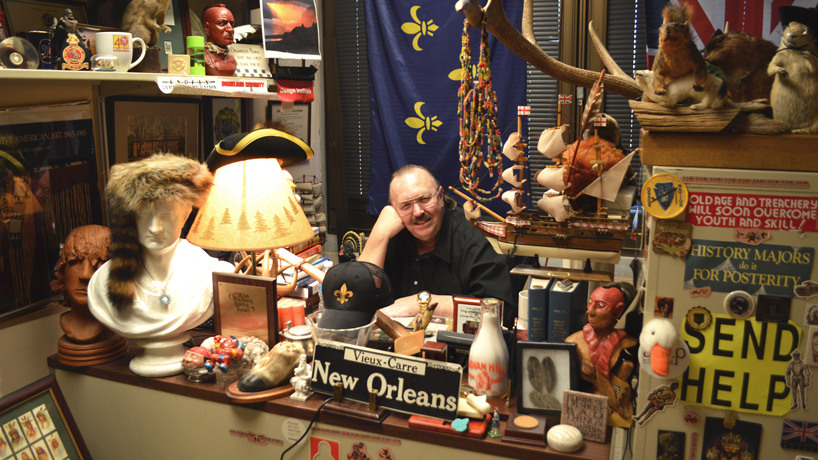
During his 26 years of service at UMSL, the professor has never grown tired of seeing history come alive for people as they hold pieces of the past in their hands. (Photo by Evie Hemphill)
Students often look a bit dazed and distracted when they visit Fred Fausz during his office hours at the University of Missouri–St. Louis. He doesn’t take it personally.
“They can’t make eye contact at all,” the history professor says with a laugh.
Competing for his visitors’ attention is a host of fascinating items – collective evidence of Fausz’s lifelong interest in the tangible stuff of history. The curiosities decorate every available surface inside the Lucas Hall space that has long been his academic home.
Pressed to show off a few of his favorites, he picks up a tiny toy dish made out of tin, explaining that it must have belonged to a Colonial-era child who grew up along the same coast he would wander decades later. Then he selects a small, centuries-old sole.
“Imagine the work that went into a child’s shoe and how you would have made another one as they grew and grew,” Fausz says of the Native American artifact in his hand. “And that beadwork – that’s just for everyday living.”
Perhaps his most prized item, his biggest find, is the beaver hat he acquired about 15 years ago, dating to 1852.
“A real beaver hat – you can’t believe how rare they are,” Fausz says. “The National Park Service will be displaying mine in the new museum under the Arch in 2018.”
That’s because Fausz is retiring this month after 26 years of service at UMSL and clearing out both an office and a home full of treasures.
While he’s selling some of the items and keeping a select few, he’s also loaning more than 70 others to the NPS. Along with the beaver hat, a number will be featured when the Museum of Westward Expansion under the Gateway Arch reopens following major renovations.
“I learned a lot through the process,” Fausz says of working with the NPS and museum staff the past few years. “I would have half a dozen people in my kitchen, in my living room, going over stuff.”
There’s that word again – “stuff.” Fausz uses it often, at times going so far as to describe his collection as “clutter.” Yet his affection for these objects runs deep, along with his belief in their usefulness in history classes and in culture as a whole – even if they do take up some room.
Trained at the College of William & Mary as an expert in Colonial history, Fausz began collecting and making use of artifacts early on in his career as a college professor. He has always made a practice of sharing such items in the broader community, too.
It’s a teaching technique that time and again sparks people’s interest in learning more about the past – and about different branches of the human family.
Take it from the 9-year-old girl whose obligatory thank-you note from years ago still draws an amused smile to Fausz’s face. Her teacher sent the note, along with others, to Fausz shortly after he visited their elementary-school classroom with a fox skin, arrowhead and other items to help illustrate his lesson.
“She wrote, ‘I wasn’t too excited,’” Fausz recalls of the young student’s particularly matter-of-fact message, “‘but the stuff you brought made your talk seem more interesting than it really was.’”
His students at UMSL have seemed to appreciate his use of the artifacts as well.
“I love the students here,” he says. “They really are fun. And some of them have gone on to have wonderful teaching careers and become collectors themselves.”
Fausz was originally hired in 1991 as dean of UMSL’s Pierre Laclede Honors College, which he built up from less than 50 students to 260 over the course of five years. Since 1996, the Department of History has been his primary unit.
His favorite course to teach over the years? The senior seminar.
“It’s a required five-credit course for history majors,” Fausz explains. “You have to do a 30-page paper, and people come in going, ‘I’ll never survive, I’ll never survive!’ But you work up to that.”
Involving twice-a-week, in-depth discussion of research, writing and books, the course is indeed a rigorous one – and Fausz earned a reputation as a tough grader over the years. But his students have regularly impressed him and risen to the occasion.
“I remember one student who wound up writing 78 pages, even though he only had to do 30,” Fausz says. “And some of them are almost on the verge of master’s-level theses.”
He’ll miss those sessions. But he’s still writing books – the latest a look at early Jamestown, Virginia – and expects to continue giving presentations throughout the St. Louis community and Midwest region now and then.
That’s something he’s really come to enjoy over the past two decades, becoming almost a sort of circuit professor. He makes stops throughout rural Missouri and beyond to bring history to life for anyone curious – and for all ages.
“More and more people say, all over the state, ‘I didn’t like history until I was 80 – this is interesting!’”















